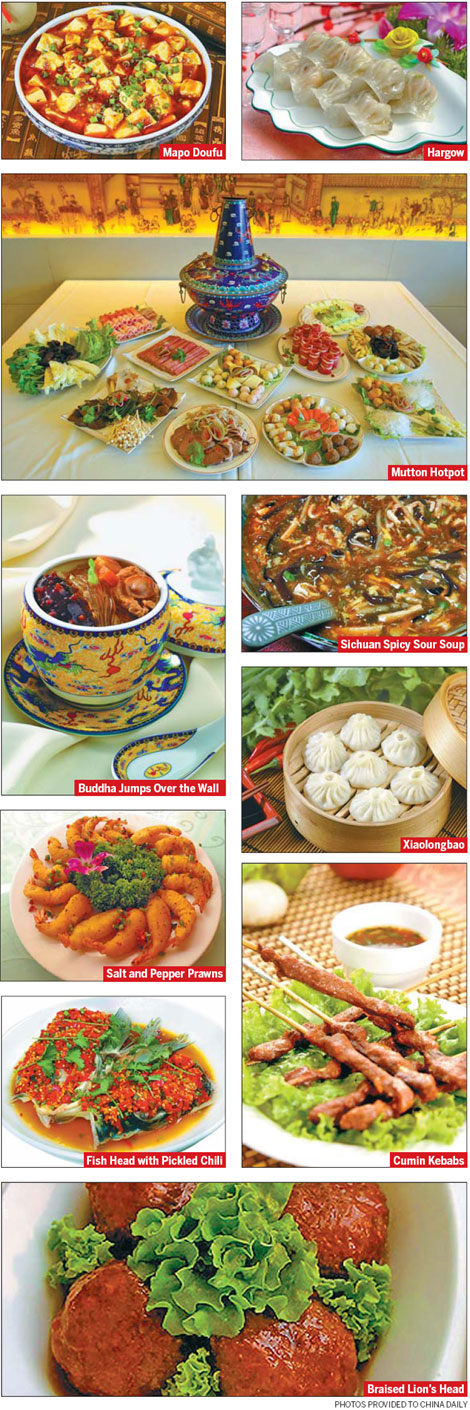Delicacies
Top tastes
Updated: 2011-07-31 08:30
(China Daily)

International media is fond of compiling endless lists of the best and worst. Chinese food, too, came under scrutiny recently when our beloved century egg was branded the most disgusting food and Peking duck listed as the fifth most delicious. We decided in the interest of national pride that we needed our own list.
No one can prepare an objective poll of just one favorite food in China. There are too many choices, too many regional favorites. But there are dishes or snacks that have transcended provincial boundaries and are available in most urban centers - the best proof of popularity.
Here are just a few of China's favorite dishes, loosely based on nationwide availability and a heated debate that fragmented our newsroom. It was a nasty breach we could only heal by going out to dinner together.
1. Mapo Doufu麻婆豆腐
Bean curd has always been a national favorite, and this dish is simple country food that has been elevated to international repute. It is as easy to find this tofu dish in San Francisco as it is in Shanghai or Sichuan, where it originates. It can be meatless, or with a smidgen of minced pork added for depth of flavor. But it is more the seasoning that makes this simple dish a hit with palates all over China and in many parts of the world. Firm bean curd is diced, and added to a wok-seared mix of ginger, garlic, scallions and a dollop of the hot bean sauce that Sichuan is so famous for. There is also a touching story behind the dish that shows that appearance may be deceiving - for who would have known that the pock-marked woman chef the dish is named after could have produced such a beautiful dish?
2. Hargow (Shrimp Dumplings)虾饺
Ahhh. Dimsum. Food that touches the heart, and none so representative of this unique Cantonese culinary culture than the tender-skinned shrimp dumpling, the hargow. The snow-white skin is made of wheat starch, which is what is left after the gluten is removed. Dimsum chefs prepare the skin with a swift swipe on the table top that transforms a little ball of dough into a paper-thin circle that will wrap up a filling made from fresh prawn and chopped bamboo shoots held together by a fragile web of pork fat that melts as the dumpling cooks. A well-made prawn dumpling is a good-looking morsel, with the pink of the prawn showing through the snowy skin like the complexion of a fair-faced beauty.
3. Mutton Hotpot涮羊肉
Nomads used to slaughter a sheep or goat in winter and gather around the boiling pot to cook the strips of meat. Perhaps the Manchurians and Mongolians hankered after this memory of the grasslands long after they deserted yak and yurt, but after having established themselves in Beijing, they brought this hotpot along. The Han Chinese, though, naturalized this dish and adopted it as their own, adding embellishments such as a wide variety of sauces and other vegetables to go with wafer-cut mutton strips. Sauces vary from region to region as the dish migrated throughout China, but some do not change, such as the sesame paste, red fermented bean curd and a pickled flowering chives sauce that challenges the olfactory senses as much as blue cheese or durian.
4. Buddha Jumps Over the Wall佛跳墙
Here is the origin of culinary excess. In China, this soup with the entrancing name of Buddha Jumps Over the Wall means no disrespect, but is simply a very graphic way of describing how delicious it is. The recipe comes from the southern Chinese province of Fujian where seafood is abundant and luxury items like abalone and dried scallops are common ingredients. This is a soup with a chicken or pork high broth base made with an entire fowl or a whole rack of ribs. That's just the start. Abalone, dried scallops, shark's fin, beche de mer, fish maw, pork ribs and often a dove's egg are placed into the broth and patiently double-boiled for a few hours in an urn sealed with parchment paper. When the soup is ready, the pot-bellied urn is individually borne to the table and the parchment paper removed, at which time, the enthusiasm of the gathered diners is supposed to equal that of leap-frogging deities succumbing to temptation.
5. Sichuan Spicy Sour Soup酸辣汤
After egg-drop soup, this is probably the most popular soup in Chinese restaurants overseas. The real thing, however, is a magical combination of heat, salt and tart flavors that makes the eating and drinking a delicious torture. Tender tofu, bamboo shoots, lean meat, black fungus and shiitake mushrooms are all sliced into hair-like julienne and then cooked in a broth with sauce and vinegar added, seasoned with a generous dash of pepper and Sichuan peppercorns. There are no sleepy diners at the table where this soup is served, and it has remained a hot favorite in restaurants far from its Sichuan home. Lithesome Chinese lasses often credit their willowy figures to frequent orders of this slimming soup.
6. Xiaolongbao小笼包
The skin must be thin enough to see through and strong enough not to break when the dumpling is dangled at the end of a pair of chopsticks. There must be at least 18 pleats formed at the top of the bun, and a tongue-burning puddle of soup inside each dumpling. These are the basic requirements for one of China's favorite snacks - the xiaolongbao or little soup dumpling. Entire restaurants have staked their reputations on how well they make these, and one, Din Tai Feng, was voted into the 10 best restaurants list by The New York Times on the strength of its delectable dumplings. At home, the restaurant has to compete with decades-old eateries in Shanghai and Hangzhou, including challenges from some Hong Kong-based restaurants. Chefs need to master the elasticity of the skin, the melt-in-the-mouth texture of the minced meat filling, and of course, the secret of that little mouthful of soup that miraculously forms when the dumplings is steamed and ready for table.
7. Salt and Pepper Prawns椒盐虾球
Seafood around the Pearl River delta is famous, and some of the best chefs come from Guangzhou where the masters of Cantonese cuisine reign. However, it is at the seafood restaurants in neighboring Hong Kong that salt and pepper prawns have achieved true international fame. Countless generations of expatriates on weekend junk trips to Lamma, Cheung Chau and Lantau Islands can testify to that. In fact, this dish has left such deep impressions that many celebrity chefs from the West have "stolen" the recipe home and claimed it as their own in hatted and starred restaurants from Sydney to San Francisco - a fact that must greatly amuse Chinese short-order cooks who can all whip up a platter of crispy skinned salt and pepper prawns without second thought. Minced garlic, chopped chili and scallion and a scattering of crushed rock salt are first heated up in a dry wok, then oil is added together with the prawns in the shell and given a searing hot five minutes over flaming heat. Easy.
8. Fish Head with Pickled Chili剁椒鱼头
This is heat that hits the eye and palate. A blanket of bright red chopped chili speckled with minced garlic, chopped coriander leaves or scallion hides a whole fish-head steamed to gelatinous tenderness. To the Chinese, it is a culmination of se xiang wei, the magic formula of color, fragrance and taste that makes a dish outstanding. I might also add texture - for the tender flaky flesh and the gelatinous bits of lips, skin and cartilage that cover the head. Not for the faint-hearted foreigner squeamish about the origins of his food and a fish eyeball staring out of the platter, but an honest down-home delicacy appreciated by the Chinese.
9. Cumin Kebabs羊肉串
These spicy kebabs were originally Uygur specialties, but with the urbanization of China, they are an almost ubiquitous snack and supper food that can be found from Xinjiang to Guangzhou and from Kunming to Beijing. They are scented with a crushed spice mix, mainly of cumin, Sichuan peppers and chili flakes. Although the hero skewers are always mutton, the kebab stalls also offer a variety of other meats, mainly off-cuts and offal, including an interesting combination of chicken breast and soft cartilage tips that is charmingly called "inseparable meat and bone", a play on the Chinese saying describing the bond between parent and child.
10. Braised Lion's Head红烧狮子头
This is the giant meatball beloved of north and south. In times when meat was scarce, mince was affordable and rendered truly delicious with a little kitchen art. The dish is so named because the meatball is large, and therefore conferred the honor of being associated with the king of beasts. It is also known by another name, Four Happiness Meatballs, for when it's served four to a platter at wedding or other celebratory banquets. Many recipes for the lion's head add filler ranging from grated lotus roots to bamboo shoots to just plain starch. The secret is in the cooking, with the meatballs first gently deep-fried to brown them, then braised over gentle fire. Finally, a rich brown sauce is poured over and they are served ringed with some blanched green cabbage. They should be so tender that they break apart at the touch of a chopstick.

Specials

Carrier set for maiden voyage
China is refitting an obsolete aircraft carrier bought from Ukraine for research and training purposes.
 Photo
Photo  Video
Video

Pulling heart strings
The 5,000-year-old guqin holds a special place for both european and Chinese music lovers

Fit to a tea
Sixth-generation member of tea family brews up new ideas to modernize a time-honored business